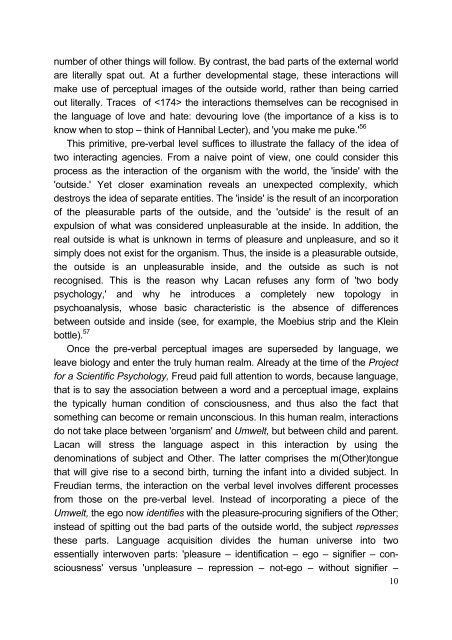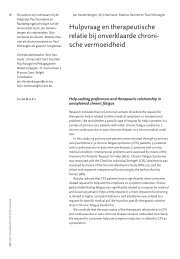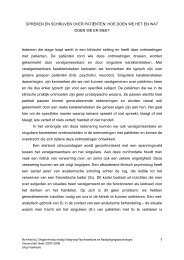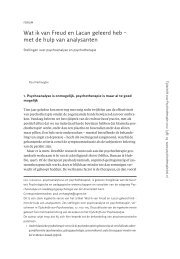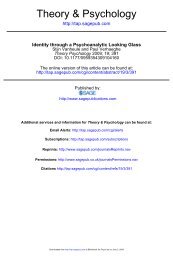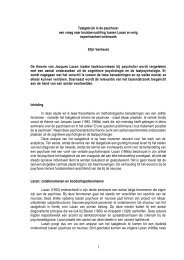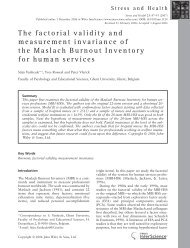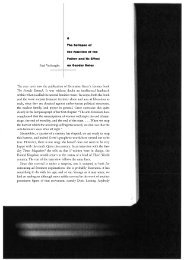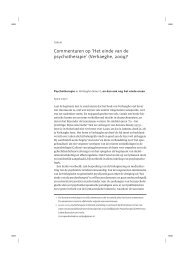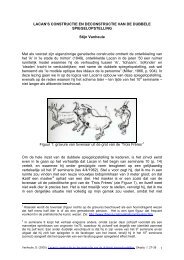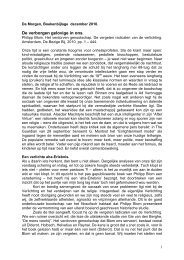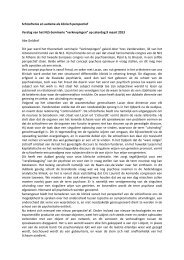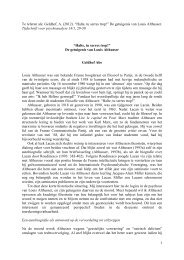Causation and Destitution of a Pre-ontological Non-entity
Causation and Destitution of a Pre-ontological Non-entity
Causation and Destitution of a Pre-ontological Non-entity
You also want an ePaper? Increase the reach of your titles
YUMPU automatically turns print PDFs into web optimized ePapers that Google loves.
number <strong>of</strong> other things will follow. By contrast, the bad parts <strong>of</strong> the external worldare literally spat out. At a further developmental stage, these interactions willmake use <strong>of</strong> perceptual images <strong>of</strong> the outside world, rather than being carriedout literally. Traces <strong>of</strong> the interactions themselves can be recognised inthe language <strong>of</strong> love <strong>and</strong> hate: devouring love (the importance <strong>of</strong> a kiss is toknow when to stop – think <strong>of</strong> Hannibal Lecter), <strong>and</strong> 'you make me puke.' 56This primitive, pre-verbal level suffices to illustrate the fallacy <strong>of</strong> the idea <strong>of</strong>two interacting agencies. From a naive point <strong>of</strong> view, one could consider thisprocess as the interaction <strong>of</strong> the organism with the world, the 'inside' with the'outside.' Yet closer examination reveals an unexpected complexity, whichdestroys the idea <strong>of</strong> separate entities. The 'inside' is the result <strong>of</strong> an incorporation<strong>of</strong> the pleasurable parts <strong>of</strong> the outside, <strong>and</strong> the 'outside' is the result <strong>of</strong> anexpulsion <strong>of</strong> what was considered unpleasurable at the inside. In addition, thereal outside is what is unknown in terms <strong>of</strong> pleasure <strong>and</strong> unpleasure, <strong>and</strong> so itsimply does not exist for the organism. Thus, the inside is a pleasurable outside,the outside is an unpleasurable inside, <strong>and</strong> the outside as such is notrecognised. This is the reason why Lacan refuses any form <strong>of</strong> 'two bodypsychology,' <strong>and</strong> why he introduces a completely new topology inpsychoanalysis, whose basic characteristic is the absence <strong>of</strong> differencesbetween outside <strong>and</strong> inside (see, for example, the Moebius strip <strong>and</strong> the Kleinbottle). 57Once the pre-verbal perceptual images are superseded by language, weleave biology <strong>and</strong> enter the truly human realm. Already at the time <strong>of</strong> the Projectfor a Scientific Psychology, Freud paid full attention to words, because language,that is to say the association between a word <strong>and</strong> a perceptual image, explainsthe typically human condition <strong>of</strong> consciousness, <strong>and</strong> thus also the fact thatsomething can become or remain unconscious. In this human realm, interactionsdo not take place between 'organism' <strong>and</strong> Umwelt, but between child <strong>and</strong> parent.Lacan will stress the language aspect in this interaction by using thedenominations <strong>of</strong> subject <strong>and</strong> Other. The latter comprises the m(Other)tonguethat will give rise to a second birth, turning the infant into a divided subject. InFreudian terms, the interaction on the verbal level involves different processesfrom those on the pre-verbal level. Instead <strong>of</strong> incorporating a piece <strong>of</strong> theUmwelt, the ego now identifies with the pleasure-procuring signifiers <strong>of</strong> the Other;instead <strong>of</strong> spitting out the bad parts <strong>of</strong> the outside world, the subject repressesthese parts. Language acquisition divides the human universe into twoessentially interwoven parts: 'pleasure – identification – ego – signifier – consciousness'versus 'unpleasure – repression – not-ego – without signifier –10


